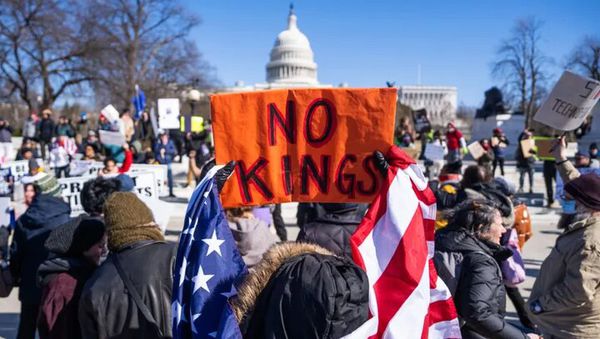As the government shutdown and economic and political crises continue, the social and political movement "No to the King" could be a turning point in American politics.
According to Ashura News, citing Mehr News Agency, on October 18, 2025, the streets of America were the scene of one of the largest waves of protest in the country’s modern history. Millions of citizens, from New York and Chicago to small villages in North Dakota, took to the streets with the slogan “No Kings.” This slogan, reminiscent of the spirit of the American Revolution in 1776, is not only a symbol of opposition to the authoritarian behavior of Donald Trump, the current US President, but also a call for a return to the fundamental principles of American democracy.
Organized by a coalition of left-wing groups, civil rights advocates, and labor unions, the protests are the third major wave of protests since Trump returned to the White House in January 2025. The scale, diversity, and message of these demonstrations reveal a deep divide in American society; a divide that transcends party lines and paints an uncertain future for American democracy.
Reasons for the Formation: Accumulation of Crises and Fear of Authoritarianism
The “No to the King” demonstrations have taken place in a context of successive crises. One of the main reasons is the unprecedented and extensive federal government shutdown that began in early October and has reached its 18th day as of the day of the protests. The shutdown is the result of a budget impasse between Democrats and Republicans; while Democrats are demanding funding for affordable health insurance programs, Republicans, with a majority in Congress, have made the budget conditional on reducing these costs.
But this is only a spark. The Trump administration’s aggressive immigration policies, the deployment of federal troops to Democratic-controlled cities, restrictions on the media and journalists, and attempts to expand executive powers have all created an atmosphere of fear of the concentration of power in the hands of one person. Protesters believe that Trump is seeking to transform the presidency into a monarchy, the very thing that the United States revolutionized against more than 250 years ago.
Goals and demands: Defending democracy and fundamental rights
The “No to the King” movement has issued a statement with four main goals that reflect widespread civil, political, and economic concerns:
1. Reject authoritarianism and the concentration of power
The organizers of the protests see Trump’s efforts to expand executive powers, deploy the military without congressional authorization, and limit the powers of oversight institutions as a threat to the separation of powers and the Constitution. They are calling for limiting executive power and restoring the balance between the three branches of government.
2. Preserving civil liberties
Media restrictions, deportation operations, and efforts to silence political opponents are among the serious concerns of civil activists. Organizations like the American Civil Liberties Union (ACLU) have stood with protesters and provided legal training to thousands of people so they can make their voices heard in a nonviolent but powerful way.
3. Reopening the Government and Economic Justice
The government shutdown has left millions of workers at home and disrupted access to public services. Protesters blame the shutdown on the preference for billionaires over ordinary people. Figures like Senator Bernie Sanders have repeatedly criticized the role of billionaires like Elon Musk, Jeff Bezos, and others in the Trump administration’s policymaking.
4. Promoting National Unity and Popular Participation
Another goal of the movement is to engage people from all walks of life across the United States. The symbol of this participation is the interactive map on the NoKings.org website, which provides directions to the nearest rally for all citizens and reiterates the slogan “Resistance begins on every street.”
Social and Political Dimensions: A Society at War
The “No to the King” protests are not just a political reaction, but a sign of a social awakening to the threats that citizens perceive to their freedoms and standards of living. The demographic mix of the protesters includes teachers, nurses, industrial workers, immigrants, sexual minority activists, and even disaffected Republicans. This diversity shows that the issue is not just partisan, but national.
On the other hand, the protests have united Democrats in an unprecedented way after months of division. From Bernie Sanders in Washington to Elizabeth Warren in Boston, prominent Democratic leaders have supported the demonstrations, calling them “a rally to save democracy.” Republicans, in turn, have reacted harshly. House Speaker Mike Johnson called the demonstrations “a hate march on America” and called the participants “antifa and anti-capitalist Marxists.” Donald Trump also said in a television interview: “I’m not a king. But they call me king because they know I have power.”
Geographic and demographic scope: from small villages to the heart of big cities
One of the unique features of the movement is its geographic scope. By the day of the event, more than 2,700 rallies had been registered in 50 states. In cities such as Washington, D.C., New York, Los Angeles and Chicago, crowds of hundreds of thousands gathered. At the same time, small cities such as Bozeman, Montana, or Providence, Rhode Island, also saw large participation. The largest statewide rally was in Providence, with more than 32,000 people. In New York, Mayor Eric Adams ensured security for the rallies, and in Boston, Mayor Michelle Wu called it “a historic moment for preserving freedom.” This scope has transformed the movement from a left-wing movement into a sweeping national event.


Post a comment